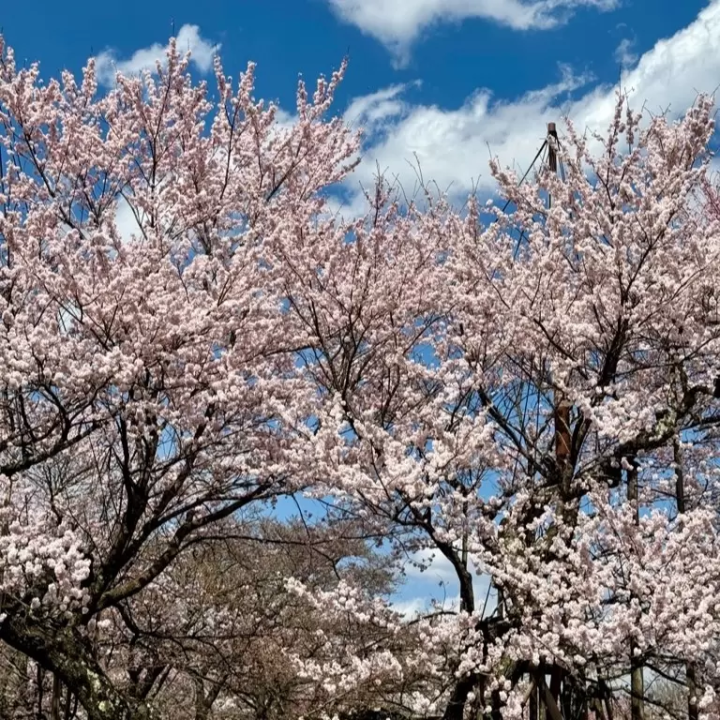A must-visit once in your lifetime! Visit the 2,000-year-old Yamataka Jindai Sakura, one of Japan's three most famous cherry trees 🤩

A must-visit once in your lifetime! Visit the 2,000-year-old Yamataka Jindai Sakura, one of Japan's three most famous cherry trees 🤩
Yamataka Jindai Cherry Blossoms 🌸

The Yamataka Jindai cherry tree at Jisso-ji Temple in Hokuto City, Yamanashi Prefecture.
It is one of the three most famous cherry trees in Japan, alongside the Miharu Takizakura in Fukushima Prefecture and the Usuzumizakura in Gifu Prefecture, and is an ancient Edohigan cherry tree that is estimated to be 2,000 years old.
You can pin it on Google Maps and drive there.
Address 📍
2763 Mukawacho Yamataka,Hokuto,Yamanashi 408-0306,Japan
There is also a parking lot.

Go through the entrance gate and enter the temple grounds.

Once inside, you will find a temizuya (also called shozuya). A temizuya is a building where water is prepared for washing your hands and mouth before praying. In Japan, there is a culture of purifying your mind and body before praying at a shrine or temple. First, scoop up water with the ladle and purify your left and right hands. Next, scoop up some water into your left hand and rinse your mouth. Finally, stand the ladle upright, purify it with the remaining water, and return it to its original position.

Within the grounds, there are small cherry blossoms from famous cherry trees all over the country, as well as the Space Cherry Blossom .

As its name suggests, this "Space Cherry Blossom" is a cherry blossom that has flown into space.
118 seeds collected by children at the local Takekawa Elementary School were sent into space by NASA aboard a space shuttle in November 2008. They then boarded the space station, spent about eight months in zero gravity, and returned to Earth in July 2009 by Koichi Wakata. Two of the seeds germinated, and one of them is in the temple grounds. What's unusual is that some of the flowers have six petals, instead of the usual five.

There is also a shop selling amulets and temple seals on the grounds.

There are so many varieties. They're all so cute!


As we walked through the grounds, we came across a 2,000-year-old Jindai Sakura tree in full bloom.
It is clear that it has been protected by human hands for a long time.

Yamataka Jindai Sakura is a type of Edohigan cherry tree, and is the oldest and largest giant tree in Japan. It was designated a national natural monument during the Taisho period. It has small petals with rounded, raised bases. The pale pink color is very beautiful.

According to legend, this 2,000-year-old cherry tree was planted by Prince Yamato Takeru, the pioneer of the Great Japanese Empire from the founding of Japan 2,000 years ago, during the Kamakura period 800 years ago.
Jindai Sakura has also been selected as one of the New 100 Famous Trees of Japan.

The area around Jindai Sakura was bustling with people trying to capture its beauty in photos.

There are also food stalls in the area.

Why not enjoy the magnificent cherry blossoms with the Southern Alps in the background?

It is two hours from Tokyo and about one hour from the Mount Fuji area.
It just reached full bloom on April 1st. If you are currently in Japan or planning to visit, this is a must - see.
It is located in the northwest of Yamanashi Prefecture, on the border with Nagano Prefecture. It is a vast area surrounded by 3,000m-class mountains such as the Yatsugatake Mountains, the Southern Alps, and Mt. Kinpu, and overlooking Mt. Fuji to the south. It is about a two-hour drive from Tokyo, about an hour from Mt. Fuji, and about an hour from Matsumoto, and is easily accessible, so many tourists visit throughout the year. It is also known as a "village of famous water," and three places have been selected as one of Japan's 100 famous water sources. This bounty of water is loved as natural water, and the area boasts one of the largest production volumes of mineral water in Japan. Sake is also produced from the pure water, and you can enjoy beautiful natural scenery and rich food.
The contents on this page may partially contain automatic translation.


























![[Next event confirmed! / Report] “Let’s Eat Tokyo Food”](https://resources.matcha-jp.com/resize/720x2000/2025/12/26-254125.webp)
![[Kanazawa] Enjoy the world of gold leaf to the fullest in the city with the highest production volume in Japan](https://resources.matcha-jp.com/resize/720x2000/2025/11/12-249564.webp)
![[2026] Family Winter Trip to Suzuka Circuit! – For Both Day trips and Overnight Stays!](https://resources.matcha-jp.com/resize/720x2000/2025/12/26-254097.webp)
![[Northern Okinawa] 4 Recommended Cosmos Fields in Okinawa | Sunflowers and Cherry Blossoms in the Same Season!](https://resources.matcha-jp.com/resize/720x2000/2024/08/12-192028.webp)
